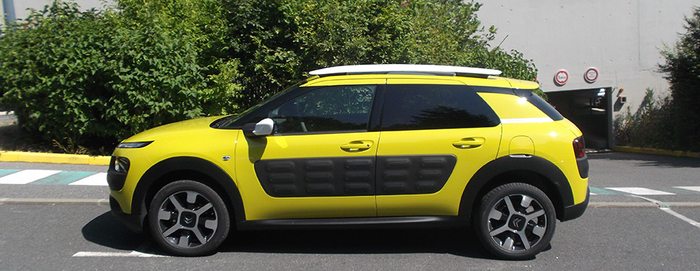Citroen C4 Cactus

When we first saw the Cactus, a few months ago, it was one of those “what on earth” moments after the cover was pulled off it. What is Citroen thinking about? was the thought in most people’s minds. Even the UK representatives from Citroen shook their heads in disbelief.

Once the dust had settled and we had chance to walk around it, looking at it from every angle, walking round it again and again, it began to sink in, that maybe, just maybe, the French had not got it wrong after all. Very soon it was liked by most, and from the glum faces, smiles began to appear.

Anyway, the time had come to see the final production version. We went to PSA offices in Velizy last week to see and drive the end product. There were several Cactus' for us to drive, or should that be several Cactus’s or Cacti? We’re not sure.
When we saw the first pre-production cars we all had that “funny” moment. We thought it looked a bit light, a bit tinny and a bit flimsy and would not feel right on the road, but first impressions can sometimes be wrong.
Citroen has decided to call the Cactus the C4 Cactus, whereas it might have been better to leave out the C4 bit saving a few euros on stick-on badges and move it away from the C4 family, just having it as a stand-alone product. Some people don’t like, or rate the C4 hatch and giving it the same name, could put some off. The C4 Picasso is another story, this car sells well and is liked, and therefore confusion is instantly added.
We drove a number of Cactus’s on the motorway, in villages, across country and it felt rock solid and safe. Despite it losing around 200kg compared to the C4 Hatch it didn’t feel as though it had been on a diet. No body roll, no wishy-washy steering (apologies to the French who may be reading this and wonder what wishy-washy is) no movement in cross-winds, or when going past a truck on the motorway at speed, it felt like a much larger and heavier car than it is.

The interior is fairly high quality and has some nice features and useful ones too. The seats are particularly comfortable on the automatics we drove. They were almost of armchair proportions, with a large armrest. You get a feeling of sinking slightly into them, but they felt firm enough for long distance trips. The cars with manual gearbox seats did not appear to be quite as luxurious, but were still a lovely place to sit for many an hour. There was plenty of room for five adults and those in the rear can easily put their feet under the front seats for extra leg room. It is incredibly quiet, with hardly any wind, engine or road noise in the cabin.
The Cactus is an alternative to a C-Segment hatch, it has more style, but above all is very different. It will have many competitors including the Nissan Juke, Renault Captur for example. Citroen expect around 70% of sales will come from other brands than their own.
The C4 Cactus measures 4,157mm long, has a boot capacity of 385 litres and with the rear seats folded 1,170 litres. The rear windows do not roll down, but rather pop-out to let air in, however, it is not as much as some would like and a few people will miss electric opening windows. But because there is no window mechanism, it helps reduce weight and gives a lot of storage space in the door pockets, you win something and then lose something.

There will be three trim levels available: Touch, Feel and Flair (who thinks of these names?) There are a couple of engines with varying power outs to choose from. There is a 1,199cc 3 cylinder Puretech (formerly known as VTi) petrol engine producing 75 or 82hp along with the turbocharged version producing 110hp. The diesel is a 1,560cc unit and will be available as the e-HDi 92hp and BlueHDi 100hp. There are also three gearboxes on offer a 5 speed manual and a 5 or 6 speed ETG semi-automatic. The CO2 emissions are as low as 82g/km and the fuel consumption a very frugal 91.1mpg. But to achieve this you have to specify the Airdream Pack on the BlueHDi engine and this is only available on the Feel trim level. The pack is no cost and reduces the wheel size, which in turn reduces the rolling resistance of the tyres.
Now to the "Cladding" on the side of the car or as it is officially known “AirBump”. These are clever plastic panels which are an integral part of the door and are there primarily to help prevent carpark damage. But they are also there to make it look different. Citroen has managed to combine design with practicality. Four colours are available, black is standard, but grey, dune and chocolate are optional. The AirBump does look substantial and should stand the test of time. The front and rear bumpers and headlight surrounds are also in the same colour and these offer additional protection.
Prices for the C4 Cactus range from £12,990.00 to £18,190.00 OTR. This Citroen is a breath of fresh air (though not when you are sat in the rear) it has great style and flair, it is fun to look at and drive and does put a smile on your face, attracts loads of attention and offers good economy, low CO2 and good value.
The French are really the only people that are brave enough and that can get away with its outlandish, quirky design. Good on them, we say.
Martin Ward, Manufacturer Relationship Manager


